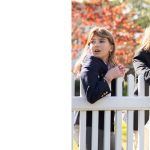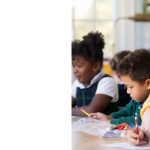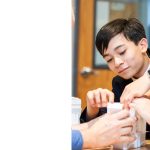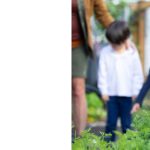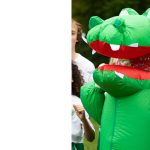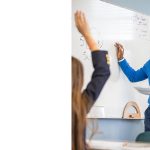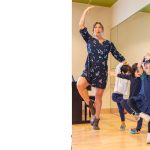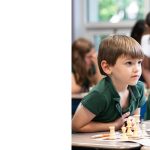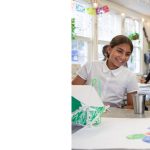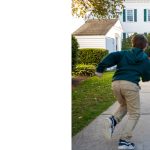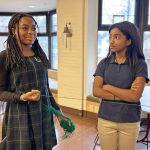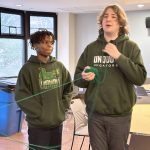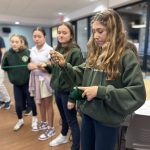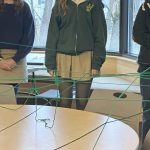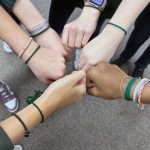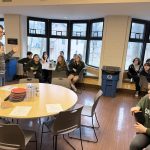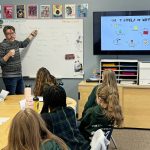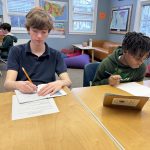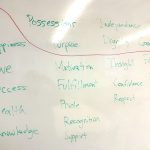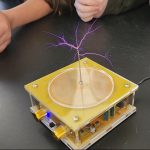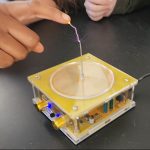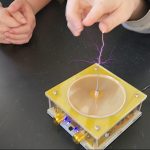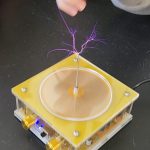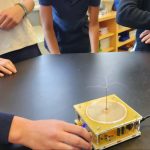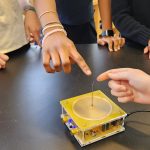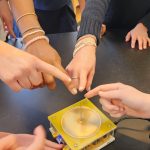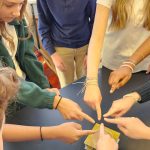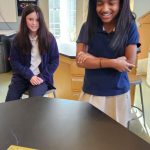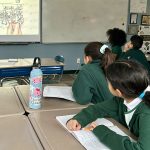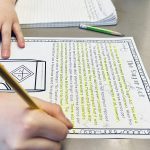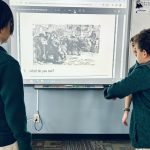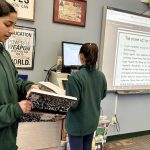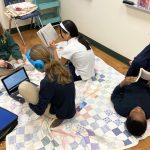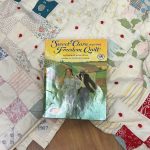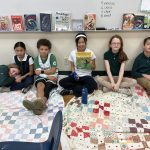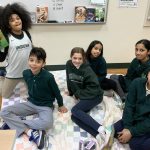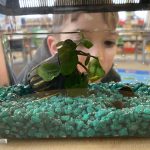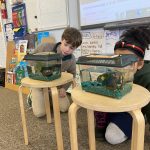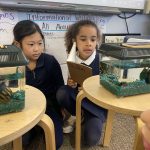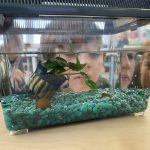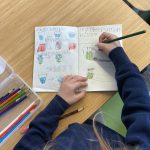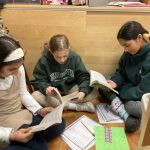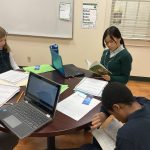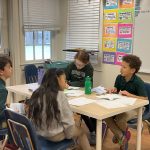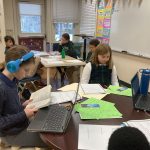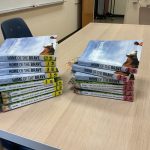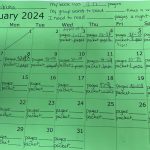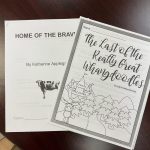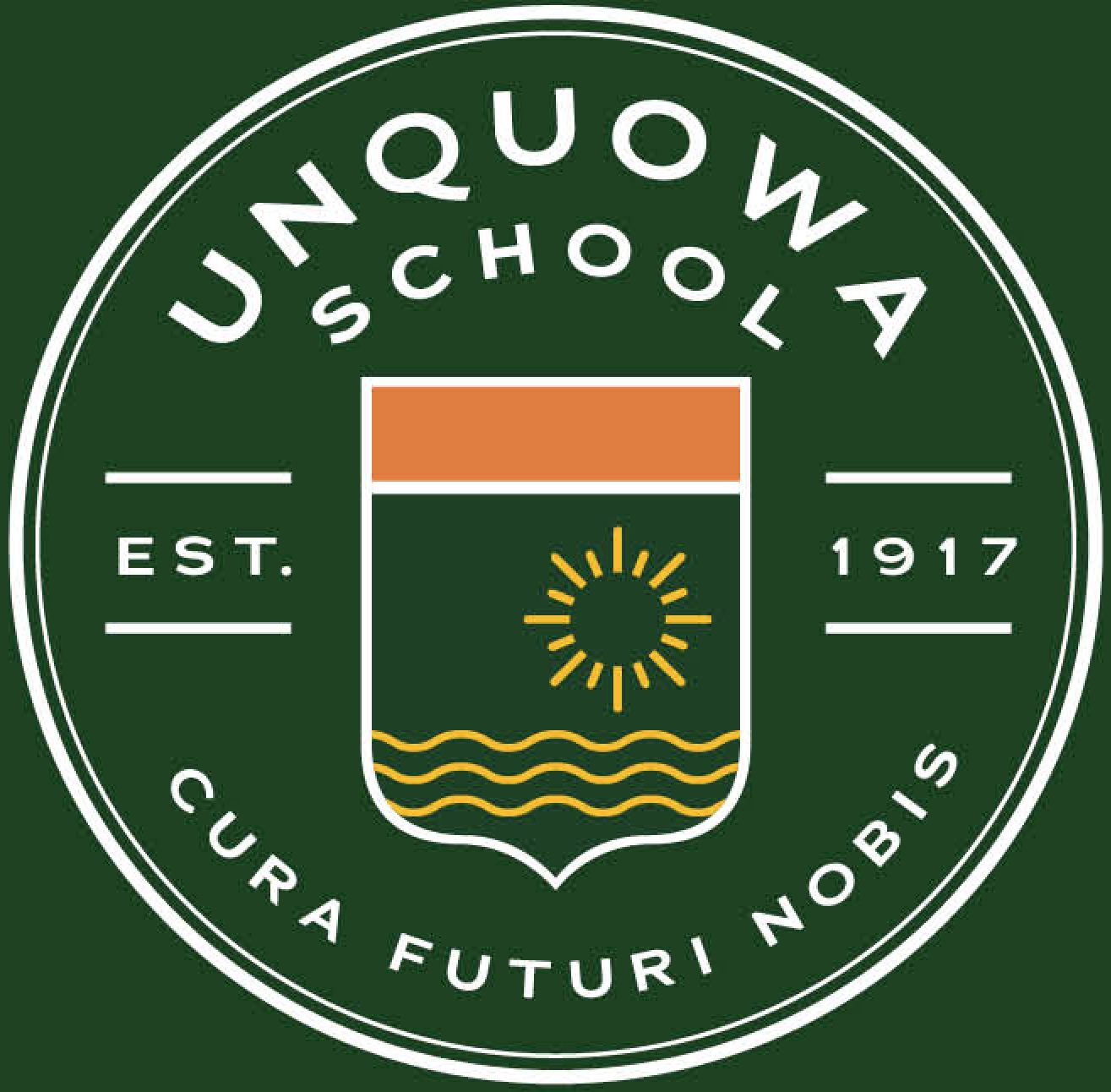Life Worth Living – Workshop Kick-off
Posted by Ariel WarshawOn Friday, February 2nd, 8th graders embarked on their first Life Worth Living workshop, facilitated by Dr. Matthew Croasmun, Director of the Life Worth Living Program at the Yale Center for Faith and Culture, and Unquowa faculty, Eric Snow and Ariel Warshaw. This workshop is part of our Life Worth Living ethics series, which includes 3 full morning workshops, and 5 sessions during Advisory. Prior to this first 3-hour morning program, students had explored elements of their own identity through reflection and guided conversations in Advisory, and then considered how societal perceptions influence their identity and desires.
We kicked off the workshop with a team-building exercise that asked the students to consider an element of their identity, and then pass a skein of yarn to a classmate to do the same. The result? A web of yarn that connected each of us to one another – there were lots of knots, some areas with more or less slack, and places we needed to repair. This served to symbolize our interconnectedness with one another, and how we can overcome challenges within ourselves and between each other. We concluded this exercise by cutting the yarn and tying a piece around our wrists, as a reminder of these lessons.
Dr. Croasmun then shared what brought him to consider, “What is really worth wanting in life?” This opened up to a larger conversation with the 8th graders around the question: “What are things people want?” They brainstormed dozens of responses – money, success, happiness, fame, health – and then considered which of these are “means” versus “ends.” Is money the ultimate goal? Or is it a means to achieve something deeper or more worth wanting, like happiness or security? We finished this portion of the workshop by learning about “The 7 Levels of Why”, which pushed students to ask “why?” from their wants, to delve deeper into their own motivations and desires.
We spent the last part of our workshop engaged in a Reflective Structured Dialogue (RSD). Three simultaneous conversations were held and facilitated by Dr. Croasmun, Eric Snow, and Ariel Warshaw. The students in each group opened the conversation by responding to the question, “What does responsibility mean to you?” Then, 8th graders unpacked the following: “Who determines what is worth wanting in life? Why? To whom am I responsible? To whom are we responsible?” Their responses were incredible – nuanced, deep, full of contradictions at times, and beautifully, imperfectly human.
We finished our workshop by looking at a few philosophical responses to these questions, looking at perspectives from Confucius (responsibility to parents), Asad Tarsinn (responsibility to God or a higher power), and Henry Taylor (responsibility to self).
We will continue to build on the theme of responsibility and the question, “What does good life look like?” over the coming weeks. As 8th graders begin to make decisions around and prepare for high school, the topics we explore will be integral to their thinking around what they truly want and who they truly are. We can’t wait to continue learning and growing with them in this process!
Plasma: The Fourth State of Matter
Posted by Joshua Bartosiewicz- Tesla Coil on! The bolts of electricity are actually ionized (supercharged) gas particles also known as “Plasma” which is the fourth state of matter.
- Giving the ionized particles a spot to discharge. This just feels like a tiny poke!
- When there’s nothing for the charged particles to escape to, they will be discharged into the path of least resistance in the gas molecules in the air!
- Changing the power and frequency of the Tesla coil.
- Everyone wants to feel the power of the Tesla coil!
- “Wow, that’s crazy it’s like mini lightening!”
As the 8th graders continue to venture into the realm of Chemistry, they’ve been learning about the states of matter and phase changes. Most people are aware of the three states of matter known as “solids, liquids and gasses”, however, there’s a fourth state of matter known as “plasma.” Not to confuse this with the plasma in our blood (they’re different), but the fourth state of matter called plasma is essentially supercharged gas particles. This state of matter makes up almost 99% of all matter in our universe! Here, on Earth, plasma can be seen as static shock, lightening, the aurora borealis or even in light bulbs and TVs!
In science we were able to utilize a Tesla Coil which was designed by Nikola Tesla in the 1800s to observe plasma in real life. When the machine was turned on, it starts producing electrical currents and builds up charges. The charges are discharged into the air around it, creating mini bolts of plasma. Students were able to manipulate where the discharges were released by moving their fingers to and from the coil. The discharges were hardly noticeable if they were even felt at all due to it being such a low intensity. The Tesla Coil allowed students to witness plasma in real time.
Who’s Paying For It?
Posted by Trésor KayumbaThe famous French and Indian War, 1754-1763 was a nuanced and complex war. A conflict which had started through diplomatic efforts, but quickly turned. This war is fascinating because it includes many elements of modern war. Big countries fighting over authority, place, while also promising a lot on the conditions that one of the countries win.
5th graders studied about the war as well as the betrayal Native Americans experienced during The Treaty of Paris, 1763. In a class discussion, students were asked to engage in dialogue and offer their perspective on the following question:
Question: Was it fair and just, for the British Parliament to impose taxes on colonies to pay war debts after the French and Indian War? Why or Why Not?
Here are their thoughts…
“Yes, it is fair because Britain paid for the colonists to get to the colonies.”
“I think it is fair to tax the colonists because Britain helped the colonists in the seven years war, but Britain should only tax a reasonable amount.”
“I think that it is okay to tax the colonists because Britain helped them win the war and the money could also go to getting more weapons if there is another war or fight.”
“No it’s not fair because they were working as a team to win, so why would your teammates need to pay you.”
“I think it is fair because they helped them with a war which is a big deal, so I think they should get paid but maybe not soooooo much money.”
“I think it is fair for Britain to tax the colonists because Britain paid a lot of money to win a war for them, but they should consult the colonists.”
Map to Freedom
Posted by Sarah RaggioIn 5th Grade literature class we read “Sweet Clara and the Freedom Quilt”, in honor of BHM. In this book, a young black girl uses her sewing talents to create a “map to freedom” in a quilt. Depicting rivers, fields and other landmarks along the way, Clara guides slaves to the Ohio River where they can find a hidden canoe and make their way to Canada via the Underground Railroad. The students were amazed by this young girl’s ingenuity and use of limited resources to gain her freedom. Sitting on old scrap quilts for the activity and learning about their origin, made it more fun.
Exploring Aquatic Wonders!
Posted by Stephanie SatonickExcitement bubbles as students dive into the world of freshwater habitats! Students have been investigating how plants and animals live in different water habitats in order to get what they need. Second grade eagerly gathered around our new freshwater snails, wide-eyed with curiosity. Armed with magnifying glasses and notebooks, they carefully observed the snails’ slow movements, intricate shells, and how they interact with their watery environment.
Cover to Cover!
Posted by Sarah RaggioGrade 5 is hitting the books in book clubs this trimester! The students are divided up into groups of three to four students per book club. The book club format is a change to our routine in literature class which is typically teacher led. Each club is reading, discussing and enjoying their book and completing a coordinating packet. Some of the students love the independent nature of the book club format, while others struggle to adapt. Some of the students have reported that they like feeling in charge and free to move at the group’s pace. Each group has calculated how many pages they need to read a day and how many packet questions they need to answer to finish up the club by mid February. Snow days have already impacted our schedule, but we will make it work! Book clubs require independence, collaboration, patience and responsibility, and of course, reading comprehension skills. It also takes a level of energy to participate in the group and self advocate. Within their group, each member is responsible for sharing their thoughts and perhaps, leading the discussion! During class each day, the students are reading and completing the coordinating packet of thought provoking questions and helping each other to find the deeper meaning of their book. Poppy feels that keeping up with the reading and packet can be a challenge, but then communicating her ideas adds a whole other level. It’s a new and fun way to read a book in class, but it is also a big responsibility. Pooja likes the book she is reading, she said, “this author has a funny way of saying things which makes me laugh. There was a river that was singing a song. I have never heard a river described like that.” Some groups read aloud, while others choose to read independently and share once they have all completed the reading. One reading aloud group is assigning parts complete with appropriate voices and accents. Some students simultaneously listen to the book while they are reading. With a variety of opinions, reading levels and thoughts, the students engage in conversation to better understand their book and foster their friendships. Each day, I eavesdrop on their discussions and feel proud of our students for expressing themselves and questioning what they know to be true, while accepting new perspectives. At times, these discussions lead to some pretty persuasive arguments and ultimately, they often agree to disagree. The students are learning to support their thinking using text evidence and feeling so proud of their new skills and independence. Ashima summed up the book clubs by saying, ” I like talking about books with my friends.” Well said, Ashima.


